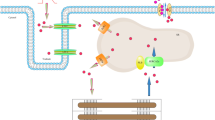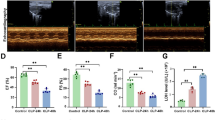Abstract
Inhibition of cardiomyocyte apoptosis plays a key role in preconditioning-triggered cardioprotection. However, the molecular mechanism(s) by which preconditioning inhibits apoptosis is not fully understood. Apoptosis repressor with caspase recruitment domain (ARC) possesses the ability to block hypoxia-induced cardiomyocyte apoptosis. We tested whether ARC contributes to the inhibitory effect of preconditioning on cardiomyocyte apoptosis. Cardiomyocytes from 1-day-old male Sprague-Dawley rats were preconditioned by exposing to 10 min of hypoxia, followed by 30 min of reoxygenation. Then, the preconditioned and non-preconditioned cardiomyocytes were exposed to 90 min of hypoxia followed by 120 min of reoxygenation. The results showed that preconditioning inhibited cell death induced by hypoxia and reoxygenation. Hypoxia and reoxygenation could induce a decrease of ARC protein levels. Intriguingly, preconditioning could maintain ARC protein levels. Inhibition of endogenous ARC expression by ARC antisense oligonucleotides reduced the inhibitory effect of preconditioning on apoptosis. Furthermore, preconditioning-induced suppression of the release of mitochondrial cytochrome c to cytosol and caspase-3 activation could be abolished by the inhibition of endogenous ARC expression using ARC antisense oligonucleotides. Conclusion: These data indicate that ARC participates in preconditioning-triggered cardioprotection by interfering with cytochrome c release and caspase-3 activation.





Similar content being viewed by others
References
van Empel VP, Bertrand AT, Hofstra L et al (2005) Myocyte apoptosis in heart failure. Cardiovasc Res 67:21–29
Gottlieb RA, Burleson KO, Kloner RA et al (1994) Reperfusion injury induces apoptosis in rabbit cardiomyocytes. J Clin Invest 94:1621–1628
Gottlieb RA, Gruo DL, Zhu JY et al (1996) Preconditioning in rabbit cardiomyocytes. J Clin Invest 97:2391–2398
Uchiyama T, Engelman RM, Maulik N et al (2004) Role of Akt signaling in mitochondrial survival pathway triggered by hypoxic preconditioning. Circulation 109:3042–3049
Piot CA, Padmanaban D, Ursell PC et al (1997) Ischemic preconditioning decreases apoptosis in rat hearts in vivo. Circulation 96:1598–1604
Hofmann K (1999) The modular nature of apoptotic signaling proteins. Cell Mol Life Sci 55:1113–1119
Nagata S (1997) Apoptosis by death factor. Cell 88:355–365
Koseki T, Inohara N, Chen S et al (1998) ARC, an inhibitor of apoptosis expressed in skeletal muscle and heart that interacts selectively with caspases. Proc Natl Acad Sci USA 95:5156–5160
Ekhterae D, Lin Z, Lundberg MS et al (1999) ARC inhibits cytochrome c release from mitochondria and protects against hypoxia-induced apoptosis in heart-derived H9c2 cells. Circ Res 85:70–77
Neuss M, Monticone R, Lundberg MS et al (2001) The apoptotic regulatory protein ARC (apoptosis repressor with caspase recruitment domain) prevents oxidant stress-mediated cell death by preserving mitochondrial function. J Biol Chem 276:33915–33922
Morihira M, Hasebe N, Baljinnyam E et al (2006) Ischemic preconditioning enhances scavenging activity of reactive oxygen species and diminishes transmural difference of infarct size. Am J Physiol Heart Circ Physiol 290:577–583
An J, Varadarajan SG, Novalija E et al (2001) Ischemic and anesthetic preconditioning reduces cytosolic [Ca2+] and improves Ca(2+) responses in intact hearts. Am J Physiol Heart Circ Physiol 281:1508–1523
Jo DG, Jun JI, Chang JW et al (2004) Calcium binding of ARC mediates regulation of caspase 8 and cell death. Mol Cell Biol 24:9763–9770
Liu GS, Cohen MV, Mochly-Rosen D et al (1999) Protein kinase C-epsilon is responsible for the protection of preconditioning in rabbit cardiomyocytes. J Mol Cell Cardiol 31:1937–1948
Mocanu MM, Bell RM, Yellon DM (2002) PI3 kinase and not p42/p44 appears to be implicated in the protection conferred by ischemic preconditioning. J Mol Cell Cardiol 34:661–668
Steenbergen C (2002) The role of p38 mitogen-activated protein kinase in myocardial ischemia/reperfusion injury: relationship to ischemic preconditioning. Basic Res Cardiol 97:276–285
Liu Y, Sato T, O’Rourke B et al (1998) Mitochondrial ATP-dependent potassium channels: novel effectors of cardioprotection? Circulation 97:2463–2469
Shimizu S, Narita M, Tsujimoto Y (1999) Bcl-2 family proteins regulate the release of apoptogenic cytochrome c by the mitochondrial channel VDAC. Nature 399:483–487
Li PF, Li J, Muller EC et al (2002) Phosphorylation by protein kinase CK2: a signaling switch for the caspase-inhibiting protein ARC. Mol Cell 10:247–258
Li P, Nijhawan D, Budihardjo I et al (1997) Cytochrome c and dATP-dependent formation of Apaf-1/caspase-9 complex initiates an apoptotic protease cascade. Cell 91:479–489
Nam YJ, Mani K, Ashton AW et al (2004) Inhibition of both the extrinsic and intrinsic death pathways through nonhomotypic death-fold interactions. Mol Cell 15:901–912
Gustafsson AB, Tsai JG, Logue SE et al (2004) Apoptosis repressor with caspase recruitment domain protects against cell death by interfering with Bax activation. J Biol Chem 279(20):21233–21238
Acknowledgments
This work was supported by grants from Chinese National Natural Scientific Fund to XiuHua Liu (Liu30620130111) and YuZhen Li (Li30570735).
Author information
Authors and Affiliations
Corresponding author
Rights and permissions
About this article
Cite this article
Li, Y.Z., Liu, X.H., Zhu, X.M. et al. ARC contributes to the inhibitory effect of preconditioning on cardiomyocyte apoptosis. Apoptosis 12, 1589–1595 (2007). https://doi.org/10.1007/s10495-007-0094-4
Published:
Issue Date:
DOI: https://doi.org/10.1007/s10495-007-0094-4




